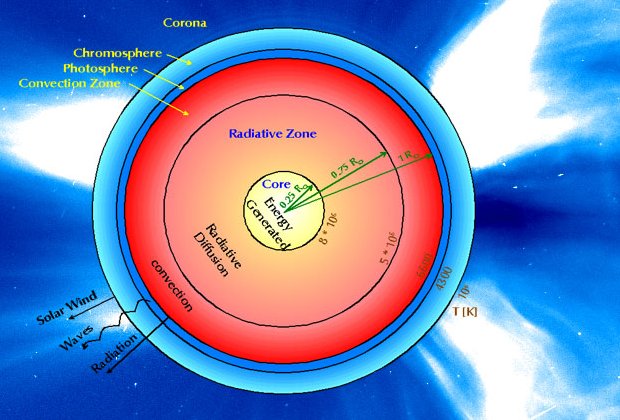 Sun
Sun Sun
Sunspaceweb@oulu.fi - last update: 22 December 1998, 2100 UT (RR)
The Sun of our solar system is a typical star of intermediate size and luminosity. It's radius is about 696000 km, and it rotates with a period that increases with latitude from 25 days at the equator to 36 days at poles. For practical reasons, the period is often taken to be 27 days. Its mass is about 2 x 1030 kg, consisting mainly of hydrogen (90%) and helium (10%). The Sun emits radio waves, X-rays, and energetic particles in addition to visible light. The total energy output, solar constant, is about 3.8 x 1033 ergs/sec.

Schematic figure constructed by Jouni Jussila using material courtesy of SOHO/LASCO
consortium.
In the core of the Sun a continuous nuclear fusion is converting hydrogen into helium at a temperature of about 16 million degrees of Kelvin. Overlaying this core region are the radiative and convective zones. The Sun has a very complex surface magnetic field created by convective flow of the electrically conducting solar material. The visible solar surface over the convective zone, called the photosphere, is at a temperature of about 6000 K. The cool (< 4000 K) regions in it are seen as sunspots.
Above the photosphere are two transparent layers. The chromosphere, visible during eclipses, extends some 10000 km above the photosphere and has a temperature of the order 10 000 K. The corona at 1-5 x 106 (or even 100 x 106) K is observable beyond chromosphere for more than 106 km (having no apparent termination). The escaping hot coronal plasma is called the solar wind. It carries the solar magnetic field to space, forming the interplanetary magnetic field (IMF) and defining the heliosphere. See the table below for the observed features above the Sun's surface.
Features occurring above the Sun's surface (photosphere) |
|
Chromospheric features |
Coronal features |
|
|
The features listed in the table above suggest that the magnetic field of the Sun is extremely complicated. However, most of the complications don't extend very far from the surface, and the magnetic field of the outer corona can often be described by a dipole or quadrupole. This is the reason behind the surprisingly simple two-sector or four-sector polarity structure of IMF at 1 AU so often observed.
Additional complications arise from the variablity of the field, which is also reflected in the Sun's activity. The destruction and recreation of the internal magnetic dipole structure occurs during a 11-year solar cycle (actually 22-year, since the dipole orientation switches after every cycle). All solar cycles are not equally intense, and it is possible that longer period modulations are operating (see global change).
Note also that fundamental changes in the Sun occur also on a time scale of 1.3-1.4 years and 154 days.
The traditional direct way to observe the Sun's activity is to look at the sunspot number. Observations of visual solar flares and radio emissions F10.7 can also be used to study solar activity. The more indirect methods include observations of geomagnetic activity that relates to solar wind parameters, or studying terrestrial C-14 variability that relate to solar wind via cosmic ray modulation.
See also
and